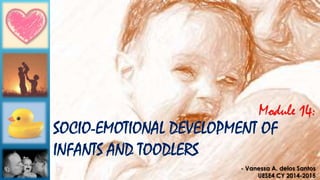
Socio emotional development of infants and toddlers
- 1. Module 14: - Vanessa A. delos Santos UESE4 CY 2014-2015
- 2. Socio-emotional Development… It refers to the developing capacity of the child from birth through five years of age to form close and secure adult and peer relationships; experience, regulate and express emotions in socially and culturally appropriate ways; and explore the environment and learn – all in the context of family, community and culture. It necessarily includes temperament, attachments and social skills.
- 3. Formative Years It is the first three years of a child where in considered as of the important in human development.
- 4. Elements on the socio-emotional development of a children: Attachment Temperament The Emergence of the Moral Self
- 5. It is a term used to describe the emotional relationship that develops between an infant and the primary caregiver, during the infant’s first year of life. It is a relationship that develops over time and is the result of many interactions and caregiving experiences, particularly those in response to the infant’s needs and bids for attention, comfort and protection.
- 6. According to Dr. John Bowly, the father of “attachment theory”, the beginnings of attachment occur within the first six months of a baby’s life with a variety of built-in signals that baby uses to keep her caregiver engaged. The key to a good start in the social development of the baby is a lot of responsive interaction with the baby. (K Pasek and R. Golinkoff, 2003).
- 7. Other relevant and research findings sited by K. Pasek and R. Golinkoff quoted in their book “Einstien Never Used Classcards” What is absolutely central to babies’ emotional well-being is not so much feeding but the consistent involvement of caregivers. Children who have good attachment relationships as infants make better adjustments in a number of areas in future life. Infants attach to more than one caregiver and they are developing emotional relationships with multiple caregivers at once.
- 8. Even when children are in child care for more than 30 hours per week, the family contributes more to child’s social and cognitive well-being than does the child care arrangement. Other relevant ….. Parents and caregivers help children regulate their emotions by working with them and by serving them as their models.
- 9. A word that “captures the ways that people differ, even at birth, in such things as their emotional reactions, activity level, attention span, persistence and ability to regulate their emotions”. The reactivity of the infant to the environment
- 10. Different Temperament Categories … 1. Activity Level 2. Mood 3. Threshold for distress 4. Rhythmicity 5. Intensity of response
- 11. Different Temperament Categories … 6. Approach - Withdrawal 7. Distractibility 8. Adaptability 9. Persistence
- 12. Three basic types of babies temperament: 1. The easy child 2. The slow-to-warm-up child 3. The difficult child
- 13. 1. The easy child easily readily establishes regular routines generally cheerful adapts readily to new experiences.
- 14. 2. The slow-to-warm-up child shows mild, low-key reactions to environmental changes negative in mood adjust slowly to new experience.
- 15. 3. The difficult child irregular in daily routines slow to accept new experiences tends to react negatively and intensely to new things
- 16. A sense of morality presupposes awareness of the existence of moral standards and the ability to evaluate oneself against standards. The Emergence of the Moral Self According to Professor Deborah Stipek and her colleagues about 50% of the 19 to 24 months olds (1 year and 7 months to 2 years old) and 80% of the 25 to 29 months old ( 2 years old to 2.5 years old) and almost all 30 to 40 months (2 years and six months to 3 years and 4 months) olds are capable of self – evaluation . Children who aren’t capable of self-evaluation and self- description don’t have the capacity to experience a sense of shame and remorse.
- 20. Train up a child in the way he should go: and when he is old, he will not depart from it.- Proverbs 22:5 Food for thought…
